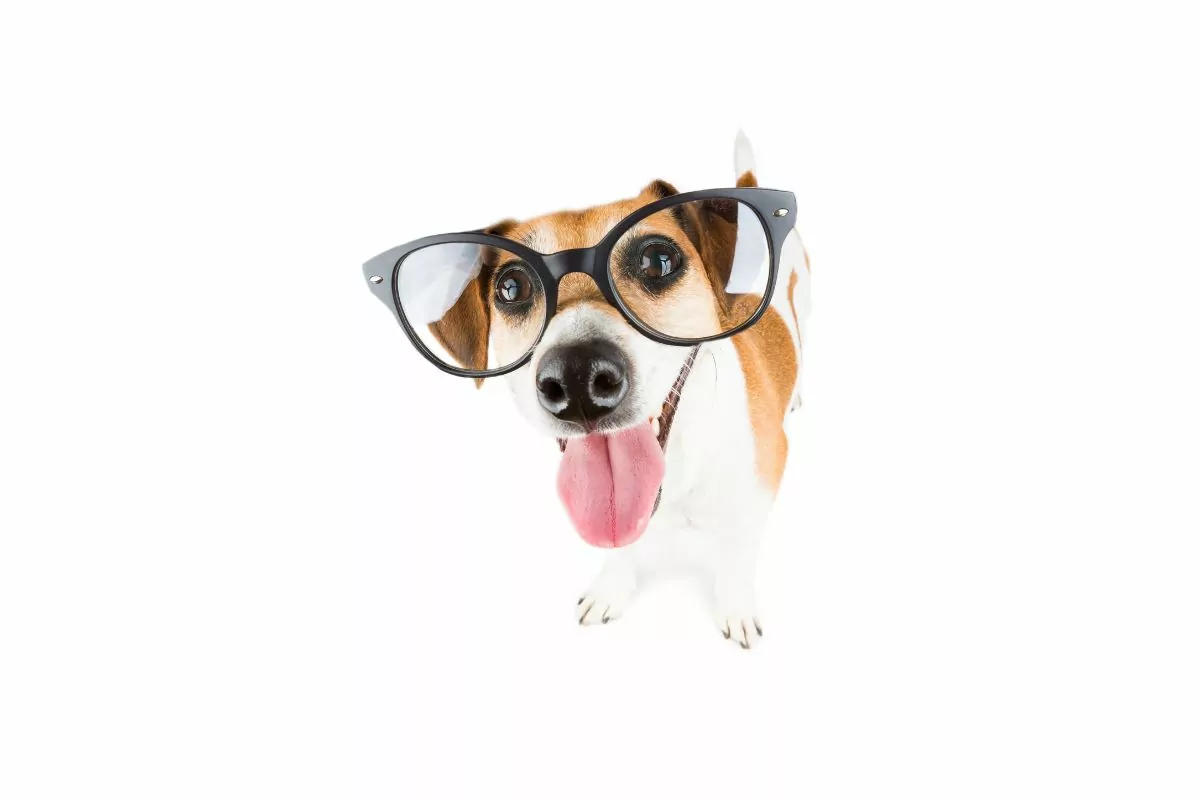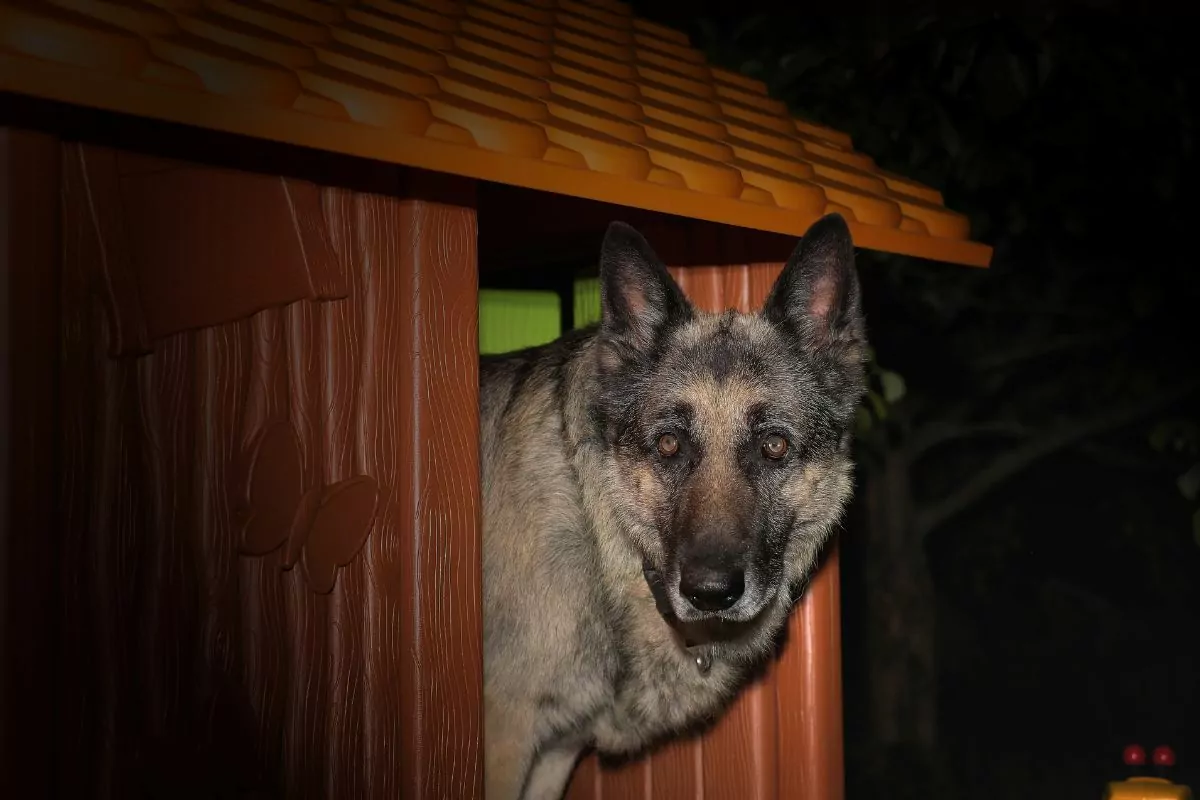Are Dogs Color Blind?
You may be wondering, what colors can dogs see? Dogs cannot see in black and white, but we would refer to them as “color-blind,” meaning that they only have two cones (or color receptors) in their eyes, compared to the average human with three.
This implies that in addition to not seeing the colors red or green, they are also unable to see hues that contain those colors, such as pink, purple, and orange.

What Colors Can Dogs See?
It is important to ask yourself, how many colors can dogs see? People can see various colors, including purple, blue, green, yellow, orange, and red. Dogs can only see blue, yellow, and a few shades of gray.
When viewed through a dog’s eyes, the rainbow colors appear dark yellow (brownish), light yellow, gray, dark blue, and light blue. Dogs don’t see purple, red, purple (violet), or orange like we do.
Dogs can differentiate between different shades of yellow, blue, and gray. However, if a dog looks at a red or green uniform, it would appear as a faded brownish color, gray, or indistinct.
What Colors Can Dogs NOT See?
When looking for gifts for their pets, dog owners frequently lean toward red toys and other items because they believe that the color red will excite the interest of a playful canine. They also think that a red object thrown into the grass will be easier for a dog to find than an object of a different color.
The unfortunate truth is that canines have a difficult perceiving the color red. When viewed through a dog’s eyes, a toy colored red to a human will appear to be more of a hue of brown, gray, or even black.
A similar problem exists with the vibrant orange color frequently on dog toys. Orange toys give off the impression of being a shade of dull or brownish-gold due to their design, which generates the appearance of great alertness and high contrast.
The irony is that choosing red or orange items may make it more difficult for your dog to tell the difference between the grass and the toy you toss back and forth.
Toys colored red and orange naturally benefit the humans involved because the human eye can see them with relative ease. This suggests that if you only want to select toys, you won’t lose in the grass, and you don’t necessarily have to fully avoid the colors red and orange.
How Do Dogs See?
You may be anxious to know; what does dog vision look like? How a dog’s eyes work is similar to how cameras. Light enters through the pupil, a hole in the iris. The iris, a structure that can expand and contract, regulates the amount of light that enters the eye. Light focuses on the retina, a light-sensitive layer, as it travels through the cornea and lens.
The retina contains color-sensitive cones and rods, which are motion- and light-sensitive. Together, they convert light into electrical signals. The brain creates an image using these impulses, transmitted from the cones and rods in the retina to the brain via the optic nerve.
Canine eyes only contain two types of cones, unlike human eyes, which have three. As a result, dogs cannot distinguish nearly as many colors as people.
Do dogs, however, see colors? Dogs are capable of seeing much more than just gray and black. Dog color vision is similar to that of the 8% of humans who cannot distinguish between green and red colors.
What Colors Do Dogs Like?
Dogs have a propensity for showing an interest in the color blue, as well as the color yellow. The explanation is simple: dogs’ innate ability to differentiate between these two hues.
Your dog will have an easier time recognizing blue and yellow toys if you choose to focus on these colors when purchasing toys for your dog. Because of this, a dog can enjoy the activity of recovering objects because they can identify colors that are immediately distinguishable against backdrops that consist of other colors that are “muted” by a dog’s vision.
This allows a dog to see more detail in the background. If you have always thought that your dog is simply awful at retrieving objects that are “right in front of his eyes,” switching to toys and objects that are blue and yellow is a good option. In reality, switching to blue and yellow toys and objects is a fantastic idea.
What Colors Do Dogs See Humans?
It is not true that dogs cannot perceive distinct colors simply because they do not share the same capacity for color appreciation that humans do over the full-color spectrum. They might not see the color of an object in its “true” form.
For instance, the color red appears to a dog as a very dark brownish-gray, almost black tint. To a dog, the colors yellow, orange, and green all seem yellowish. Our four-legged pals have excellent vision for the color blue, yet they mistake the color purple for blue.
Regarding the game of fetch, dogs cannot differentiate between a yellow ball and a red one. When they are out in the park engaging in a game of fetch, they usually recognize their ball and steer clear of any confusion because they have a fantastic sense of smell.
Other visual distinctions exist between canines and humans, in addition to variances in color perception. Canines and humans see the world differently in several ways, including color perception. When compared to human eyesight, dog vision is lacking in certain respects.
Our four-legged friends are less susceptible to variations in brightness. Said dogs cannot detect color in complex and brilliant tones.

What Makes a Color Colorful?
The eyes contain nerve cells that are responsible for color perception. Rods, responsible for detecting light levels and motion, and cones, responsible for color discrimination, are the two primary types of cells in the eye’s retina.
The human eye contains three different types of cones, each of which can distinguish between various color combinations involving red, blue, and green. Dichromatic vision is the term that describes dogs’ limited color perception because they only have two types of cones and can only distinguish between blue and yellow.
Dogs have more rods in their eyes, which gives them the advantage when it comes to seeing in dim light or recognizing moving objects. Humans may have more cones, enabling humans to see more colors and perceive them brighter than dogs do; however, dogs have more rods.
What is Color Blindness?
Alterations in one’s capacity to sense color collectively use color blindness. The severity of color blindness in humans is directly proportional to the number and kind of color receptors in the eye that are absent or dysfunctional. People might be red-green colorblind or blue-yellow colorblind, the two most common types of this form of colorblindness.
A person who is colorblind to both red and green will be unable to tell the difference between the two hues. That sure does put a damper on the holiday spirit! Similarly, a person who is colorblind to blue and yellow will not be able to discern the difference between clothing that is yellow or blue.
In terms of being able to differentiate between colors, a dog’s normal eyesight is most comparable to that of a person who is colorblind to red and green. There have not been any additional degrees of color blindness observed in canines.
The Visual Differences Between Canines and Humans
There are various optical advantages that canines have over humans. Dogs have eyes that are in a manner that places them more on the sides of their heads, giving them a wider field of peripheral vision than we have. Dogs’ eyes have a narrower range of visual acuity than ours, which means they do not have the same sense of depth.
Dogs can take in the most light because their pupils can dilate to their fullest potential. In addition, they have reflecting cells located under the retina that make up the tapetum. The tapetum not only gives dogs the appearance of having “bright eyes,” but it also helps their vision in low-light conditions.
In addition, dogs’ retinas contain a greater number of rod cells than those of their human counterparts. Rods are the components that are responsible for the detection of light and motion, including the detection of minute movements at enormous distances.
Therefore, compared to humans, dogs have a stronger vision in low-light conditions (dusk and dawn) and can detect movement with greater precision.
Why Do Dogs See What They See?
The natural environment bestows dogs with specialized visual adaptations that improve their chances of surviving and thriving there. The dog’s capacity to hunt improves by its ability to see well in dim light and to detect even the slightest movements in the forest, even at a considerable distance.
These qualities also assist a dog in recognizing when it is in the position of the prey and the need to flee. The times are changing, and most dogs are now members of the human households they live with, which means that we feed them nourishing food and shield them from dangerous animals. Despite this, the canine family still holds most of these visual talents.

The Bottom Line
To summarize, it is a common misconception that dogs cannot distinguish between colors. However, because their retinas only have two cones, they can only discern a smaller range of colors than ours, which has three cones. When compared to the colors that humans see, the colors that dogs do see are less vibrant.
This is something that we can claim with a high degree of certainty. When training or playing with dogs, the first step in correcting color misunderstandings is to go against the tendency to use red and orange things with them. This is the first stage in addressing color misconceptions.
The final word is that blue and yellow are the two colors that attract dogs the most simply because these are the two colors that are easy to identify. This is why blue and yellow are the most attractive to dogs. Read our article and find out about Conjunctivitis in Dogs.
